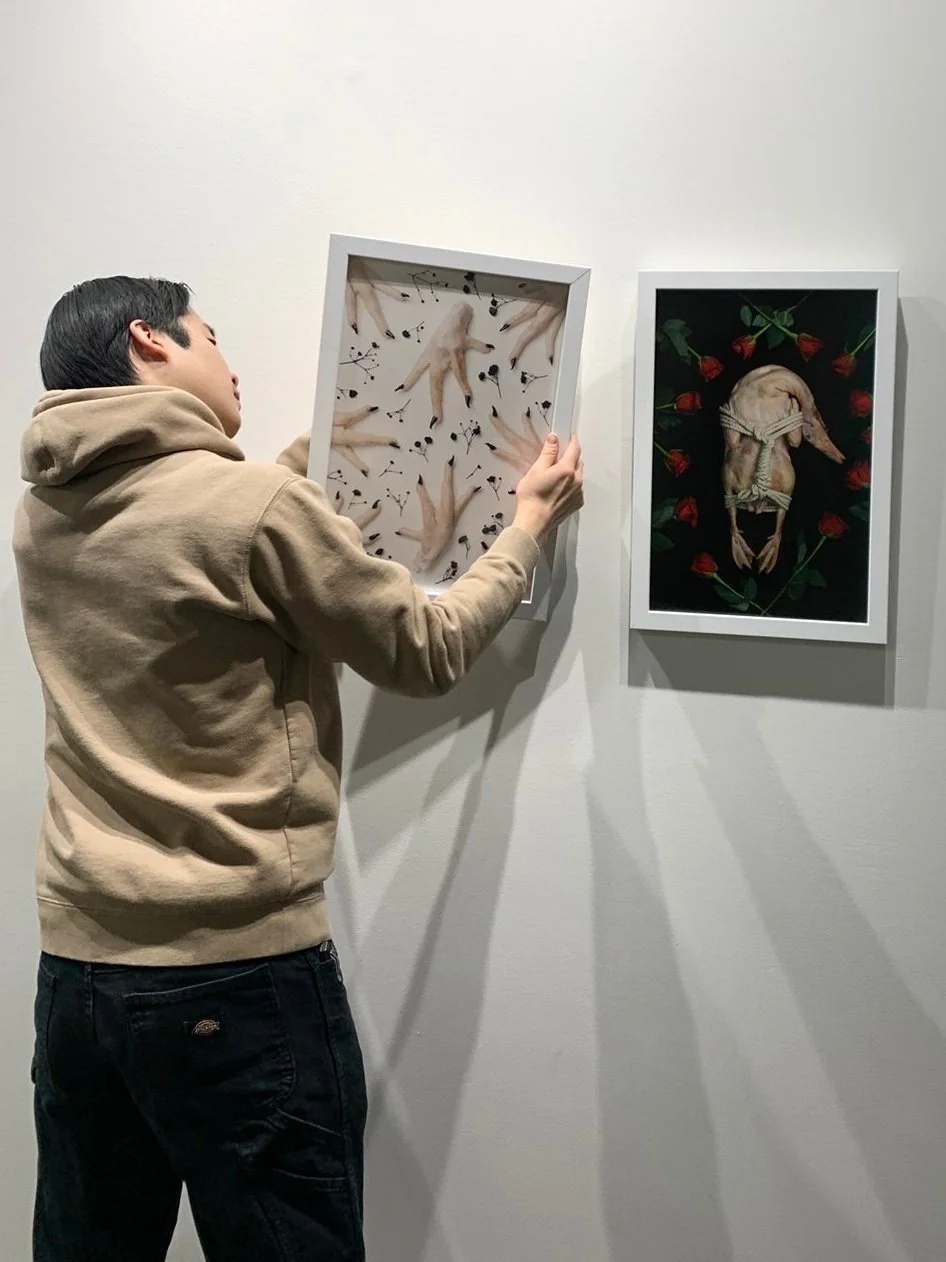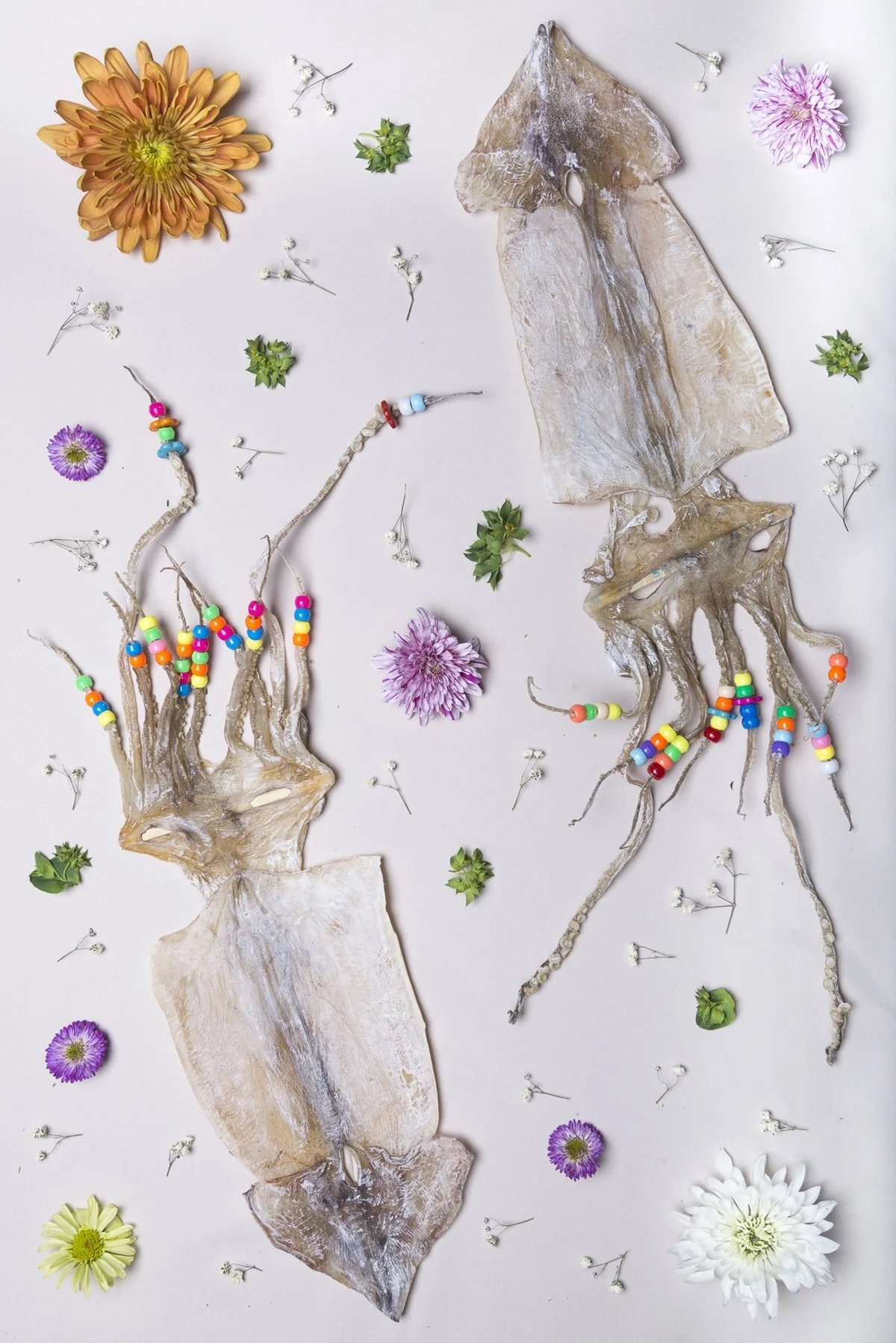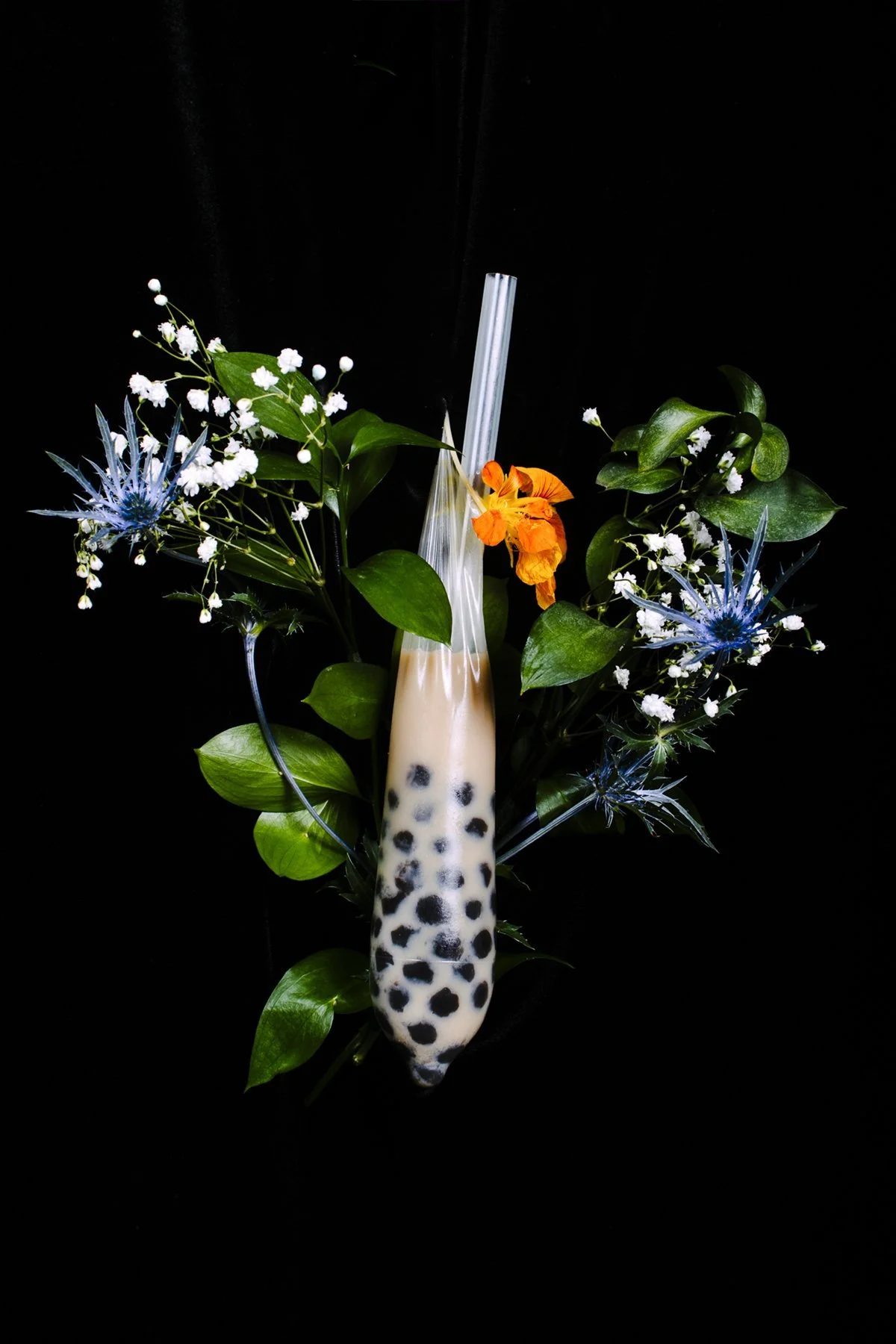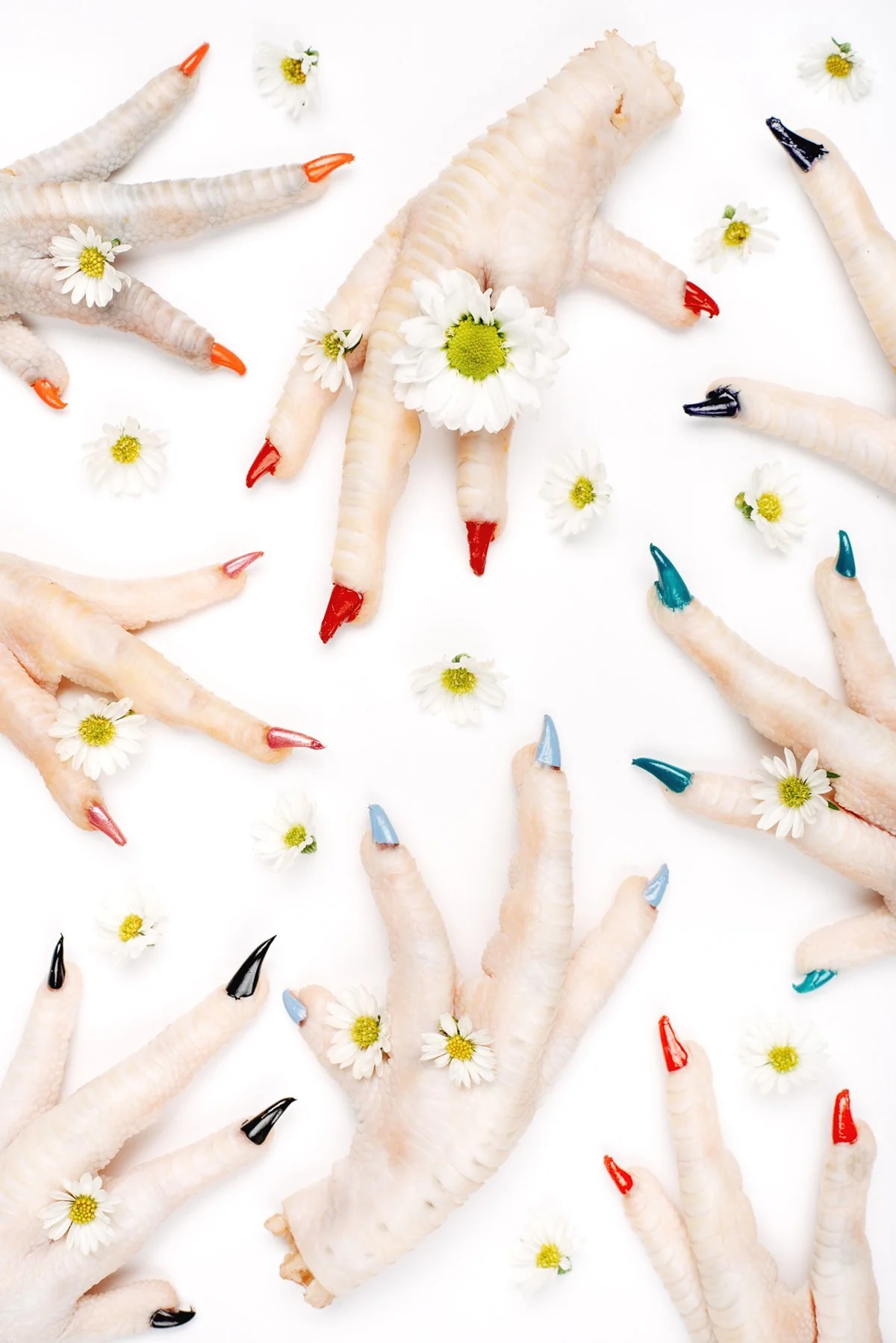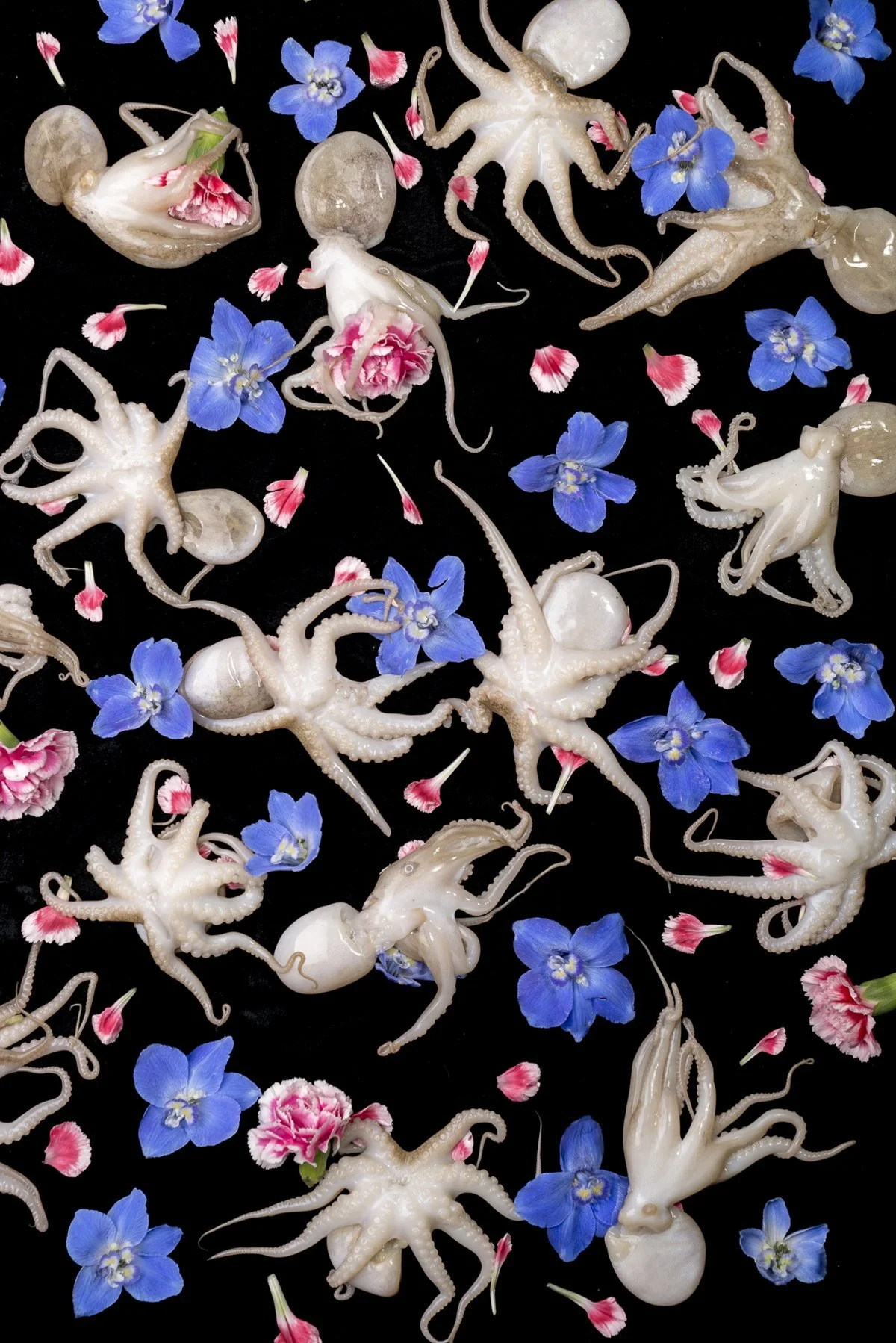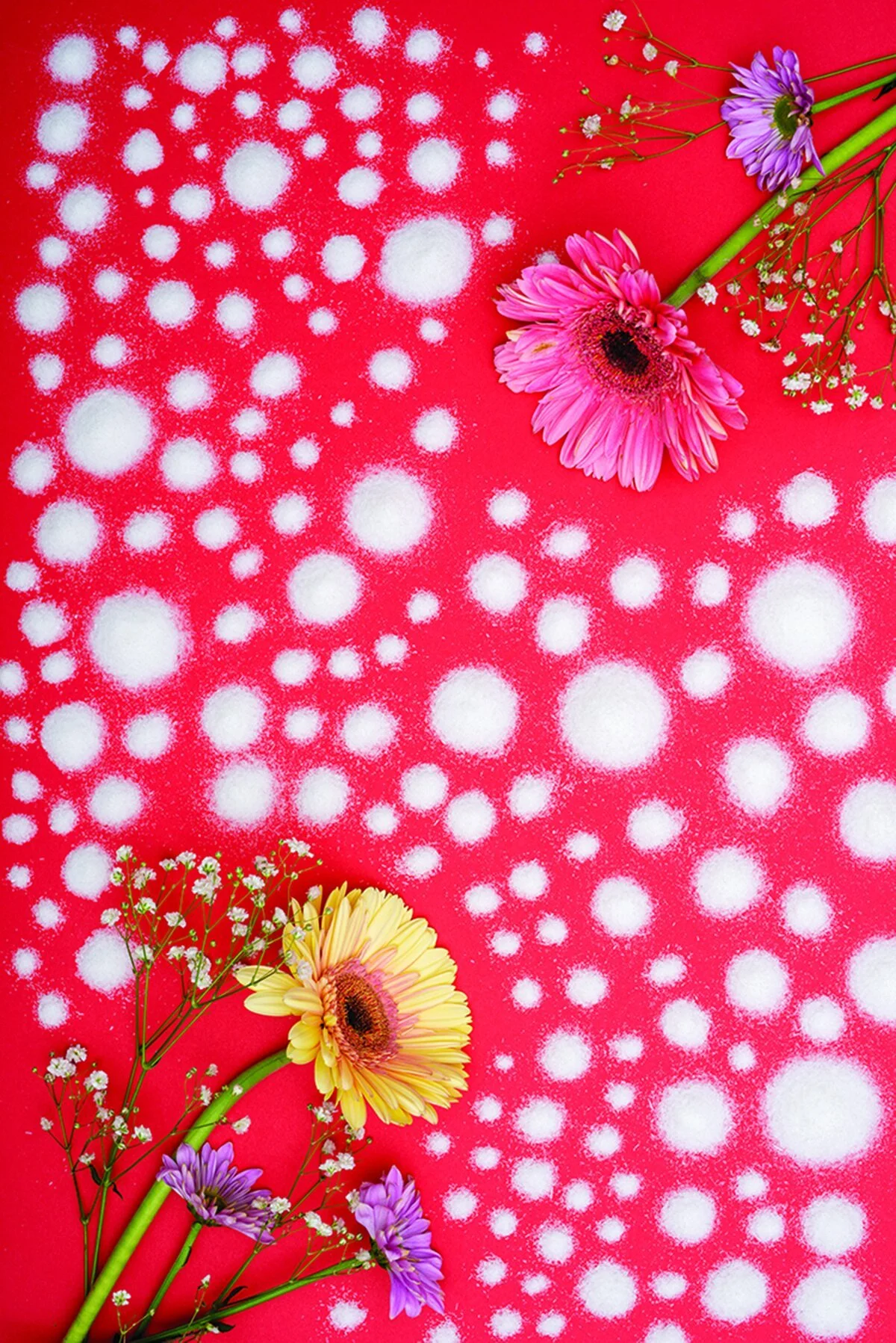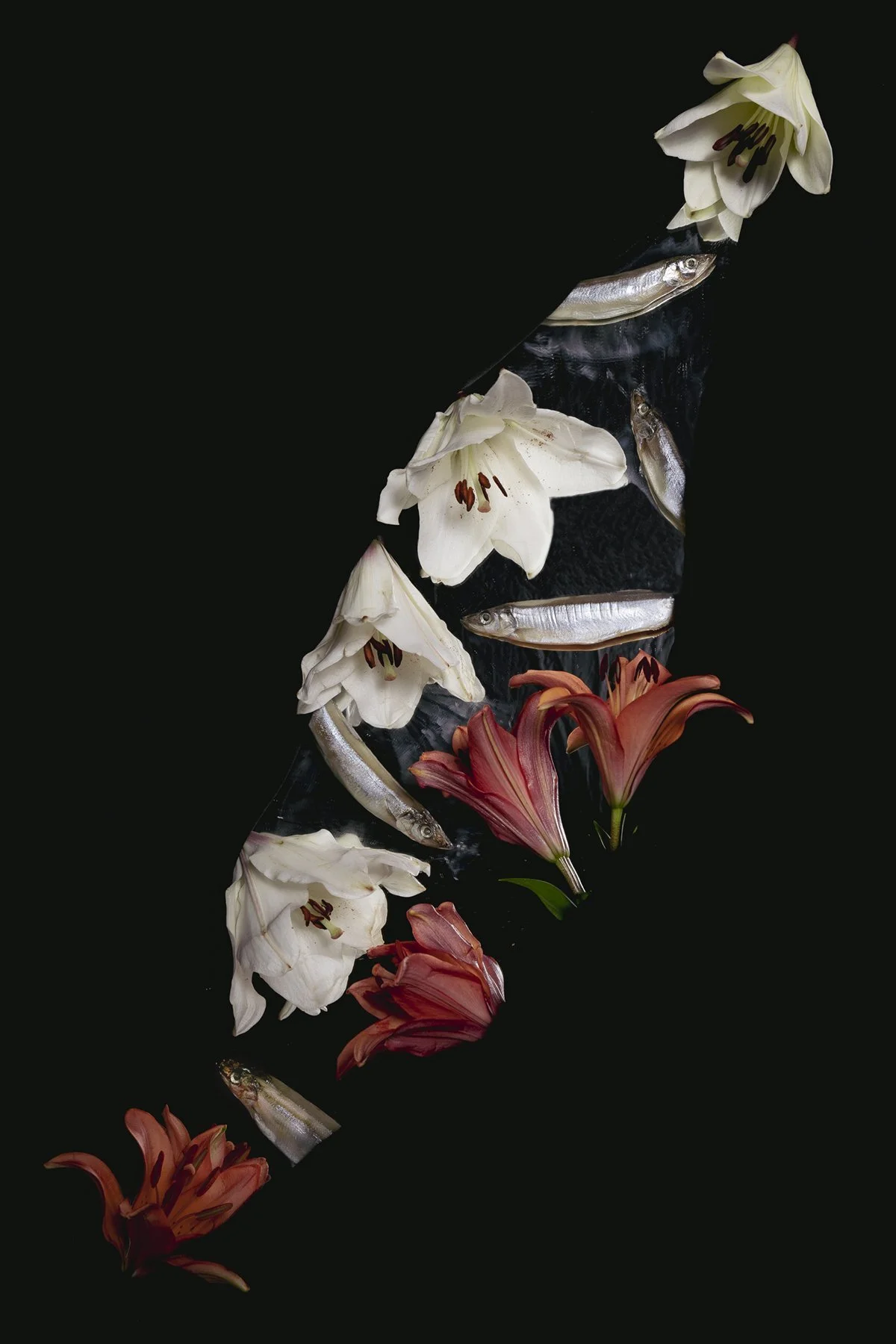Published in Denver Art Review, Inquiry, Analysis (DARIA), Spring Issue.
Photo by Parker Yamasaki.
Thomas Yi isn’t sure what to share with me. I ask him what he likes to do outside of photography—any hobbies?—and he retreats into his own head. To fill the space between us, he laughs at thoughts that I don’t have access to, while nervously calculating: What should I tell her, what does it matter, what will she write?
Thomas Yi with his photographs Chicken Feet and Acrylic Nail Polish (left) and Tied Duck (right), both 2018. Photo by Parker Yamasaki.
In front of us, displayed on a white roller cabinet, are prints of Squid with Beads (2018) and Boba Tea Condom (2018), which are exactly what they sound like, but prettier. In Squid with Beads, two flattened and dried squid—their tentacles strung with fluorescent plastic beads—lie opposite one another on a bright white background sprinkled with flowers. The photo is a nod to Yi’s childhood, crunching on freshly roasted squid, which was his dad’s favorite snack. He calls it “weak.” “It’s too obvious,” he elaborates. “The beads; it’s obviously an allusion to childhood.” While I disagree, I understand the artist’s inclination to squirm at past work. Yi made Squid With Beads as a BFA student at the University of Colorado Boulder. And while his more recent works aren’t quite so “obvious,” all contain echoes of his past.
Thomas Yi, Squid with Beads, 2018, archival pigment print, 20 x 28 inches. Image courtesy of the artist.
Yi grew up around food in Littleton, just south of Denver. His parents—both Korean immigrants—owned an American-style diner where Yi spent his afternoons as a teen. Eventually he worked at that diner, before transferring his skills to various kitchen jobs in Denver. In 2016 he was admitted to the University of Colorado Boulder to study film, but a BFA foundations class redirected him toward photography. His images reference both the food and the cinema that have influenced him, a wily mix of Wong Kar-wai and City Wok takeout.
Thomas Yi, Boba Tea Condom, 2018, archival pigment print, 20 x 28 inches. Image courtesy of the artist.
While Yi definitely knows how to distance himself from his work, to call him guarded would be a mischaracterization. His photographs are a deliberate mix of discomfort, sensuality, and silliness—a mix that isn’t shy at all. In Tied Duck (2018), a naked duck carcass is intricately bound by a thick rope, its head is contorted back toward itself. In Chicken Feet and Acrylic Nail Polish (2018), a borderless pattern of splayed chicken feet and daisy heads dapple the frame. The nails on each foot are painted in glossy hues—teal, orange, red, black. And, of course, there’s Boba Tea Condom (2018), a tightly composed image of verdant green leaves, sharp thistles, and the eponymous condom full of coffee-colored milk tea and tapioca balls.
What seems absurd at first is subdued with prolonged exposure, and the forcefully suggestive current of Tied Duck, after a lingering look, ebbs to a naked duck bound in rope. On the other hand, some images bloom in the other direction, from familiar to the absurd. What appear from afar as manicured hands are actually chicken feet; their polished nails growing more strange with each subsequent look.
Thomas Yi, Tied Duck, 2018, archival pigment print, 16 x 20 inches. Image courtesy of the artist.
Thomas Yi, Chicken Feet and Acrylic Nail Polish, 2018, archival pigment print, 16 x 20 inches. Image courtesy of the artist.
There’s a BIPOC binary offered in America: assimilate or exaggerate, and artists tend to choose the latter. But Yi’s photographs pull both ends toward a shared center. He de-sensationalizes edible symbols of difference—chicken feet, duck’s heads, dried squid—by adorning them with glamor or absurdity. It’s this third form of representation that Yi has created in his photographs, one that digests both of its extremes.
One print that does this particularly well is Octopus Arrangement (2019). “Arrangement” seems the right word here—the image is too sparse for a collage, and more asymmetrical than a pattern. Bite-sized octopuses and violets fill and exit the frame. Unlike many of his other photographs which adhere closer to a still-life setup, Octopus has no center.
Thomas Yi, Octopus Arrangement, 2019, archival pigment print, 16 x 20 inches. Image courtesy of the artist.
Also unlike his other works, in which the quote-unquote ugly components are dressed up, the octopuses and the flowers are nearly as beautiful as one another. Octopuses with the color and sheen of moonlight twist among the conventional beauty of flowers. It’s not a “this” versus “that” statement, it’s a wholly pleasing visual, which is what Yi says is closer to his message.
Yi doesn’t want his photographs to be straight-forward representations of Korean American identity, because he’s just one Korean American. His identity is that of Thomas Yi, photographer, first-generation American, son of the owners of the Silver Creek Diner. By the same token, he does think about the fact that other people of color, especially Asian Americans, will see something of their own stories in his work. It’s acknowledgment without needing to say anything; it’s a head nod, it’s eye contact.
Thomas Yi, strange harm from electric fans, 2023, archival pigment print, 16 x 20 inches. Image courtesy of the artist.
Thomas Yi, MSG, 2022, archival pigment print, 20 x 28 inches. Image courtesy of the artist.
“A lot of us grew up in restaurants. Like family-owned places, and we worked in them, and now we’re out here and we're concerned with the same things…so how can we talk about that?” Yi says. “Still, our stories are vastly different. It’s through art [that] I'm able to say, like: here's my version. [My images] bring me back. I hope they bring other people back to their own upbringing or their family.”
Over the course of our afternoon, Yi references a lot of Asian image-makers: Michiko Kon, Ai Wei Wei, Bong Joon-ho, Wong Kar-wai. We’re looking at one of Yi’s prints, MSG (2021), which features a solid yellow background pocked by tiny piles of the savory flavor-maker. “I mean, Yayoi Kusama,” he says, deflecting my enjoyment of the image toward its influence. Sure, but also, Yi.
He is also quick to direct my gaze toward his peers and coworkers at CU Boulder, where he now works as a laboratory coordinator in the Integrated Media Arts Practices department. I ask to see his office and he takes me on a tour of the whole rest of the building—skirting his own office until the last possible moment—while stopping to admire work on display and talk about other artists as we pass their studios. His enduring “nothing to see here” attitude benefits those around him, onto whom he generously layers indulgent descriptions and compliments.
Thomas Yi, Yuddy, 2022, archival pigment print, 16 x 20 inches. Image courtesy of the artist.
Yi is relatively new to the art world, and that might account for some of his hesitation to spotlight himself. What should he tell me, what does it matter, what will I write? As an artist he puts something of himself into the world for others to absorb. It’s a vulnerable position that requires, for some, years of hardening.
But his hyper-self-awareness could also stem from his Asian American identity coupled with his focus on representation. This awareness is demanded from children of immigrants, and most people of color in America. What will make you stand out in the right way? In the wrong way? Is it finally cool to eat kimchi in America? It’s a process of figuring out a position that doesn’t neglect autonomy, but that doesn’t separate you so much that uniqueness is all you have. The resulting behavior is a balance so delicate and lifelong that for many it’s nearly subconscious.
Modern parlance calls it code-switching, but that doesn’t really get at the whole-body experience of constant calibration. The concept of code-switching also suggests a distinction, of simultaneous but separate worlds that can be toggled between. But Yi’s photographs inhabit the more realistic middle—a sum made up of more than its parts. For Yi, that calibration is expressed in glamorous and demanding photographs that contrast his careful presence. Yi, so assertive and unapologetic in photos, so giggly and distant about his hobbies. Of course, I could have it all wrong. Maybe Thomas Yi just doesn’t like to talk about his hobbies.
